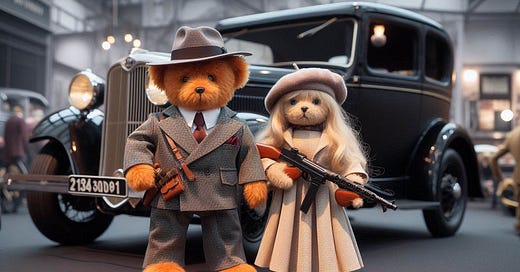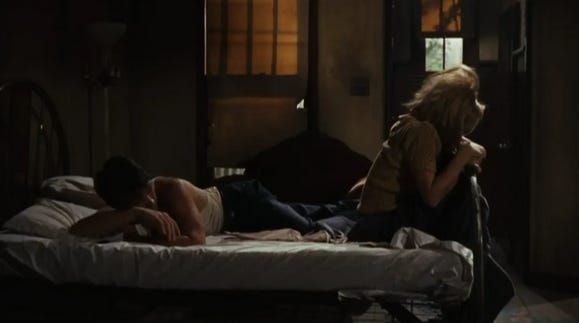1967 was the year where things began to shift in U.S. film. From the bloated corpses of the studio system’s failed musicals and historical epics rose a crop of young directors. They were influenced by foreign films, embraced the counterculture, and sought realism above all else. Their arrival coincided with the death of the Hays code, which gave these young directors opportunities to tell stories of sex and violence. One of those stories was Bonnie and Clyde.
The unfulfilled Bonnie Parker (Faye Dunaway) catches glamorous Clyde Barrow (Warren Beatty) trying to steal her mother’s car. She finds this alluring for some reason and lets him take her out for Cokes. He shows her his gun1 and she challenges him to use it2, so he robs a store and the two flee the scene. Clyde’s gun skills belie his impotence3, but no matter—Bonnie falls in love with Clyde because he sees her, already knows her whole story. And then they start robbin’ banks.
The Barrow gang adds to its ranks by picking up mechanic C. W.4 (Michael J. Pollard), Clyde’s brother Buck Barrow (Gene Hackman), and Buck’s wife Blanche (Estelle Parsons). Unfortunately, it’s to diminishing returns: while Dunaway and Beatty are electric, the rest of the cast adds little. The plot also peters out quickly, lurching through tedious shootouts and car chases. Perhaps the violence was shocking in 1967, but in 2025 it feels like watching two hours of your little brother playing Grand Theft Auto.
So here’s what happens: Buck is killed in a shootout and Blanche is captured. Bonnie publishes a poem, “The Ballad of Bonnie and Clyde,” and Clyde marvels that “you’ve made me somebody they’re gonna remember.” That fixes his impotence. Then the Texas Rangers, led by Frank Hamer (Denver Pyle) track Bonnie and Clyde down, set a trap, and blow them away.
Bonnie and Clyde was a defining early film in what would be called New Hollywood, but that wasn’t obvious immediately. Warner Brothers was concerned about the film’s commercial potential and critic Bosley Crowther called it “a cheap piece of bald-faced slapstick comedy.” But others were more bullish: Roger Ebert said it was “clearly the best American film of the year” and Pauline Kael wrote a 9,000-word apologia for it. I hate to disagree with Ebert and Kael, but…
Rating: 5/10, it’s a cheap piece of bald-faced slapstick comedy.
Cast and Crew
You might not get why Bonnie and Clyde was such a meaningful departure for Warren Beatty if you don’t know the persona he cultivated before that film.5 He was the all-American boy, the lover who dated troubled girls, a movie star you liked but that you’d seen before. His first film role was the maudlin melodrama Splendor in the Grass (1961), directed by Elia Kazan.6 In it, he’s beautiful, brooding, and tormented, and he’s desired by a challenging woman whose sexuality makes her go crazy.
Beatty’s next movies, including The Roman Spring of Mrs. Stone (1961) and a bunch we’re consigning to a footnote7, follow similar patterns. But the role of Clyde Barrow is a clear departure: take that all-American boy and turn him into a counterculture icon, a hyper-violent but charismatic outlaw. The recipe worked: the film was a critical and commercial hit, and because Beatty both starred and produced, he became one of Hollywood’s main characters. We’ll be seeing a lot more of him.
Faye Dunaway was a relative unknown when she landed the part of Bonnie Parker. To get the part, she beat out a murderer’s row of actresses, including Jane Fonda, Tuesday Weld, Ann-Margret, Leslie Caron, and Natalie Wood. But yeah, you can see what they saw in her.
Quick Hits:
Estelle Parsons won a Best Supporting Actress trophy for her role as Blanche. Her performance is screechy and awful.8 She may be better known today for playing Roseanne’s mom on “Roseanne” and “The Conners.”
The film was directed by Arthur Penn. He also directed The Miracle Worker (1962) and the proto-New Hollywood Warren Beatty movie Mickey One (1965).
The song “Foggy Mountain Breakdown” by Flatt and Scruggs refrains through the chase scenes of the film. Earl Scruggs was a banjo player who popularized the three-finger picking style.
Gene Hackman, who played Buck Barrow, died last week. We’ll see Hackman in leading roles before long, but for now, I’ll leave you with an obituary from The Ringer.
The Trivia
Today’s Trivia is on Depression-era organized crime. First up: Al Capone. Also called “Scarface” because of the scar on his face, Capone got his big break when he moved to Chicago and became the bodyguard of bootlegger Johnny Torrio. When Torrio handed the keys to the Chicago Outfit over to Capone, Capone expanded his bootlegging business through violence. He’d say “all I do is satisfy a public demand” and was seen as a modern-day Robin Hood…
…until he burned all his goodwill by ordering the 1929 St. Valentine’s Day Massacre, a hit on seven of Bugs Moran’s North Side gang.

This brought lots of attention from the fuzz and Capone was eventually brought down on charges of tax evasion. Frank Nitti, Capone’s deputy, took over for the Outfit after Capone was sent away.
That’s Chicago. You gotta know New York gangsters too, starting with the Sicilian-born Lucky Luciano. Luciano was head of one of the Five Families9 and created the Commission—basically the Mafia’s board of directors—which gave all the crime families equal power.10 In 1936, U.S. Attorney (and future New York governor and guy from famous headline) Thomas Dewey busted Lucky for running a mammoth prostitution ring. Luciano was imprisoned and his aide Frank Costello became the family boss.
Two other New York mobsters to know: buddies Meyer Lansky, a Jewish gangster known as the “Mob’s Accountant,” and Bugsy Siegel. The two (along with Luciano and others) began the National Crime Syndicate, which pooled resources between Irish, Italian, and Jewish gangs. Their enforcement arm was called Murder, Inc. (headed up by Albert Anastasia). Lanksy and Siegel were instrumental in building casinos in Las Vegas, but Siegel’s mismanagement of the Flamingo led to the Syndicate rubbing him out.
Speed Round: Disorganized Crime
John Dillinger: a bank robber from Indiana who was “Public Enemy Number 1.” His downfall is famous: he was betrayed by Anna Sage (a madam known as “the woman in red”) and the FBI (led by Chicago field office head Melvin Purvis) gunned him down at the Biograph Theater.
Baby Face Nelson: an associate of Dillinger whom the FBI killed five months later.
Pretty Boy Floyd: A bank robber who allegedly burned mortgage records during heists. He became Public Enemy Number 1 after Dillinger died, and Melvin Purvis brought him down as well. Here’s Woody Guthrie singing about PBF.
Machine Gun Kelly. Bootlegger turned kidnapper known for
his relationship with Megan Foxthe phrase “G-Man” and his cool name.The Barker-Karpis Gang: another notorious gang, but this one’s neat because it was allegedly controlled by Fred Barker’s mother, Ma Barker.
These “public enemies” enjoyed notoriety and were considered by some to be folk heroes. Context is king: it was the Great Depression and banks were the enemy, so why not root for bank robbers? I suppose it’s similar to some of the discourse around Luigi Mangione today.
Odds and Ends
“We rob banks”: #41 on the “100 Years…100 Movie Quotes” list…this film was comedian Gene Wilder’s first role…life advice: “it’s the face powder that gets a man interested, but it’s the baking powder that keeps him at home”…costume designer Theadora Van Runkle suggested Dunaway’s “Bonnie” look: long skirts, a beret, and a short jacket…another gangster: Enoch “Nucky” Johnson, an Atlantic City crime boss; Steve Buscemi later played a fictionalized version of him in “Boardwalk Empire”…the film’s tagline: “They’re young, they’re in love, and they kill people”…songs that riff on the symbolism of Bonnie and Clyde include Eminem’s “97 Bonnie and Clyde” and Jay-Z and Beyoncé’s “03 Bonnie and Clyde.”
In 2017, the 50th anniversary of Bonnie and Clyde, Dunaway and Beatty got to hand out the Best Picture trophy at the Oscars. Rebels to the end, the pair gave it to the wrong movie.
Not a euphemism, though it’s extremely euphemistic.
See Footnote 1.
This plot point is fictional. The real Clyde Barrow was likely raped in prison, though, which led to rumors of impotence and homosexuality.
C. W. is a mashup of multiple different real-life Bonnie and Clyde sidekicks.
Starting with his role as “rich jock” on TV show “The Many Loves of Dobie Gillis.”
Splendor in the Grass had a screenplay from William Inge, and Beatty had already scored a Tony nomination for his work on Broadway in the Inge play “A Loss of Roses.”
The films: All Fall Down (1962, another Inge screenplay with Beatty as a sexy bad boy), Lilith (1964, another weird romance), Promise Her Anything (1965, he’s in a love triangle), Mickey One (1965, he’s a playboy pursued by the mob), and Kaleidoscope (1966, he’s James Bond-esque).
Don’t worry, the real Blanche Barrow thought so too: according to IMDB, she believed the script made her look like “a screaming horse’s ass” and sued Warner Bros. over her depiction in the film. (And she wasn’t the only one—the family of Texas Ranger Frank Hamer also sued the film.)
Those five families today are the Genovese (this one was the Luciano family previously), Colombo, Lucchese, Bonanno, and Gambino. A crime family is led by a boss, an underboss, and a consigliere. Below them are crews, each headed by a capo and staffed with soldiers. We’re gonna watch lots of gangster movies so I’m sure we’ll come back to all this.
A story about the Commission in action: Jewish bootlegger and racketeer Dutch Schultz went to the Commission to ask if he could kill U.S. Attorney Thomas Dewey. They said no, he said he was gonna do it anyway, and the Commission rubbed him out.








